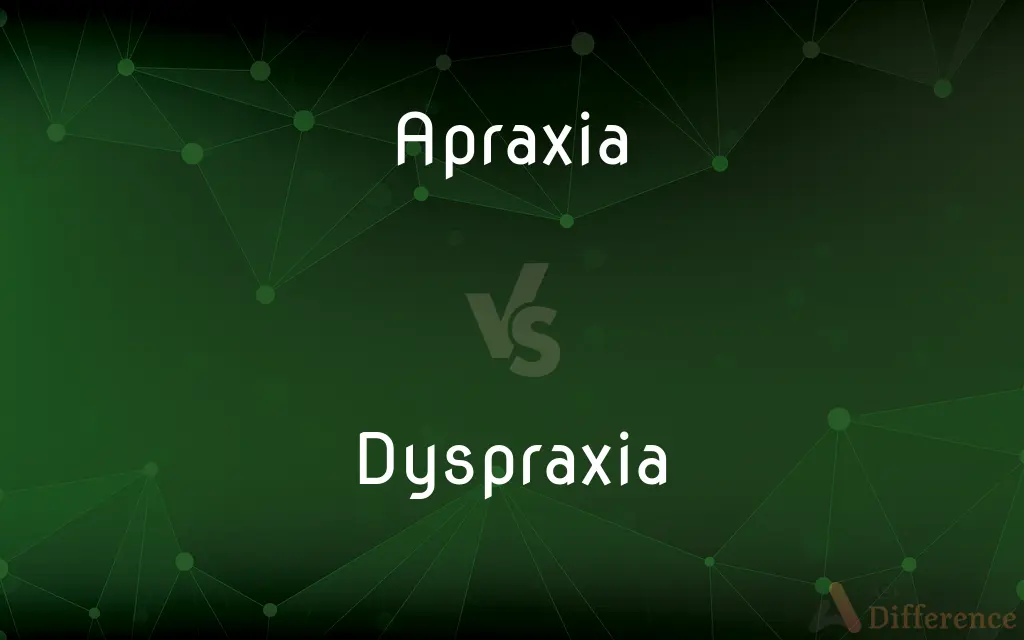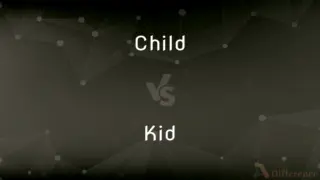Apraxia vs. Dyspraxia — What's the Difference?
Edited by Tayyaba Rehman — By Fiza Rafique — Updated on March 13, 2024
Apraxia is a motor disorder affecting voluntary movement execution despite having the desire and physical capacity, while dyspraxia involves difficulties with motor planning and coordination, often impacting daily activities.

Difference Between Apraxia and Dyspraxia
Table of Contents
ADVERTISEMENT
Key Differences
Apraxia involves the challenge in executing voluntary motor movements, despite the muscles being physically capable and the desire to perform the movement being present. This condition often results from neurological damage. Whereas, dyspraxia, also known as developmental coordination disorder, impacts an individual's ability to plan and process motor tasks. People with dyspraxia might struggle with routine activities requiring fine motor skills, such as writing.
Individuals with apraxia find it difficult to perform tasks on command due to a disconnect between the brain and the specific motor movements, even though they understand the task. On the other hand, those with dyspraxia may have the ability to understand and command their bodies to move but face challenges in executing movements smoothly and accurately, affecting their coordination and spatial awareness.
Apraxia often results from neurological issues such as stroke, brain injury, or degenerative diseases, which impact the brain's motor planning areas. In contrast, dyspraxia is generally recognized as a developmental disorder, with its exact causes being less clear but often observed from early childhood and affecting learning and daily functioning.
Treatment approaches for apraxia typically involve speech and occupational therapy, focusing on improving specific motor tasks and compensating for lost abilities. Dyspraxia, however, may require a broader approach, including physical therapy, occupational therapy, and strategies to enhance learning and daily functioning, addressing both motor skills and potential educational challenges.
While apraxia usually refers to specific types of motor execution problems, such as in speech (apraxia of speech), dyspraxia can encompass a wider range of motor coordination issues, affecting not just specific tasks but also general physical activities and sometimes cognitive functions related to spatial and temporal organization.
ADVERTISEMENT
Comparison Chart
Definition
A neurological condition affecting voluntary movement execution.
A developmental disorder impacting motor planning and coordination.
Causes
Often results from stroke, brain injury, or degenerative diseases.
Largely unknown, but recognized from early childhood.
Impact
Affects ability to perform specific motor tasks on command.
Affects broad motor coordination, including fine and gross motor skills.
Treatment
Speech and occupational therapy focusing on specific motor tasks.
Multifaceted approach including physical, occupational therapy, and educational strategies.
Typical Onset
Can occur at any age due to neurological damage.
Usually identified in early childhood, affecting development and learning.
Compare with Definitions
Apraxia
Difficulty with voluntary movements despite having the ability and desire.
A person with motor apraxia may struggle to wave goodbye.
Dyspraxia
Difficulty in coordinating fine and gross motor skills.
A child with dyspraxia may struggle with handwriting exercises at school.
Apraxia
Difficulty executing motor commands following verbal instructions.
A person with ideomotor apraxia might not be able to mimic brushing their teeth on command.
Dyspraxia
Issues with small movements, such as writing or buttoning shirts.
Fastening buttons can be a frustrating task for someone with fine motor dyspraxia.
Apraxia
Difficulty with fine motor movements of the limbs.
Tying shoelaces can be challenging for someone with limb-kinetic apraxia.
Dyspraxia
Challenges with coordinating mouth and tongue movements for speech.
Oral dyspraxia can make it difficult for someone to pronounce complex words clearly.
Apraxia
A specific type of apraxia impacting the ability to form words correctly.
Despite understanding language, someone with apraxia of speech may have trouble saying hello.
Dyspraxia
Difficulty with large movements, like jumping or running.
A person with gross motor dyspraxia might find sports like basketball challenging.
Apraxia
Difficulty understanding the use of tools and objects.
Someone with conceptual apraxia may struggle with the idea of using a key to unlock a door.
Dyspraxia
Difficulty processing sensory information to make appropriate motor actions.
A child with sensory dyspraxia may be overwhelmed by noisy environments, affecting their motor responses.
Apraxia
Apraxia is a motor disorder caused by damage to the brain (specifically the posterior parietal cortex or corpus callosum) which causes difficulty with motor planning to perform tasks or movements. The nature of the damage determines the disorder's severity, and the absence of sensory loss or paralysis helps to explain the level of difficulty.
Dyspraxia
A developmental disorder of the brain in childhood causing difficulty in activities requiring coordination and movement.
Apraxia
Inability to perform particular purposive actions, as a result of brain damage
Dressing apraxia
Dyspraxia
(medicine) A genetic neurological disorder where a person has motor skills severely below average due to their brain's inability to consistently send messages accurately to the body for the planning of motor movements.
He had to quit dishwashing at the restaurant because his dyspraxia made him unable to do the work.
Apraxia
Total or partial loss of the ability to perform coordinated movements or manipulate objects in the absence of motor or sensory impairment.
Apraxia
(neurology) Total or partial loss of the ability to perform coordinated movements or manipulate objects in the absence of motor or sensory impairment; specifically, a disorder of motor planning.
Apraxia
Inability to make purposeful movements, but without paralysis or loss of sensory function.
Apraxia
Inability to make purposeful movements
Common Curiosities
What is the main difference between apraxia and dyspraxia?
Apraxia is about the inability to execute motor movements despite understanding and physical ability, whereas dyspraxia involves difficulties in motor planning and coordination.
Can apraxia affect speech?
Yes, apraxia can specifically impact speech, known as apraxia of speech, affecting the ability to form words correctly.
Can adults have dyspraxia?
Yes, while dyspraxia is typically identified in childhood, its effects can continue into adulthood, affecting daily tasks and potentially professional activities.
How is apraxia diagnosed?
Apraxia is diagnosed through neurological assessments and evaluations by healthcare professionals, focusing on the individual's ability to perform motor tasks.
Are apraxia and dyspraxia treatable?
Both conditions can be managed with therapy and support, though they may not be entirely curable. Treatment focuses on improving functionality and quality of life.
Can dyspraxia affect social skills?
Yes, the challenges associated with dyspraxia, such as difficulty in coordination and communication, can impact social interactions and skills.
Do apraxia and dyspraxia only affect children?
While apraxia can develop due to brain damage at any age, dyspraxia is typically identified in childhood. However, both can continue to affect individuals into adulthood.
Is there a genetic link to apraxia or dyspraxia?
Some research suggests there could be genetic factors involved in both conditions, but more studies are needed for conclusive evidence.
Are there any specific educational strategies for children with dyspraxia?
Yes, tailored educational strategies that accommodate motor coordination challenges can significantly benefit children with dyspraxia.
Is dyspraxia considered a learning disability?
Dyspraxia is often associated with learning challenges due to its impact on motor skills and sometimes cognitive functions, but it is primarily a motor coordination disorder.
What causes dyspraxia?
The exact causes of dyspraxia are not well understood, but it is thought to involve disruptions in the way the brain communicates with the body.
Can stress or anxiety worsen apraxia or dyspraxia?
Stress and anxiety can exacerbate the symptoms of both apraxia and dyspraxia, making it harder to manage motor tasks.
Is apraxia a form of autism?
Apraxia is not a form of autism, though it can occur in individuals with autism. It is a separate motor disorder.
Is there a cure for apraxia or dyspraxia?
There is no cure, but with appropriate therapy and support, individuals can improve their abilities and manage symptoms effectively.
Can physical therapy help with dyspraxia?
Yes, physical therapy is a key component of treatment for dyspraxia, helping to improve motor skills and coordination.
Share Your Discovery

Previous Comparison
Child vs. Kid
Next Comparison
Krill vs. ShrimpAuthor Spotlight
Written by
Fiza RafiqueFiza Rafique is a skilled content writer at AskDifference.com, where she meticulously refines and enhances written pieces. Drawing from her vast editorial expertise, Fiza ensures clarity, accuracy, and precision in every article. Passionate about language, she continually seeks to elevate the quality of content for readers worldwide.
Edited by
Tayyaba RehmanTayyaba Rehman is a distinguished writer, currently serving as a primary contributor to askdifference.com. As a researcher in semantics and etymology, Tayyaba's passion for the complexity of languages and their distinctions has found a perfect home on the platform. Tayyaba delves into the intricacies of language, distinguishing between commonly confused words and phrases, thereby providing clarity for readers worldwide.















































